Featured
Taking aim at weapons
January 4, 2013
In the aftermath of last month’s horrific Sandy Hook Elementary School shooting, we once again find ourselves talking about how we must reduce gun violence and confront the easy access our society provides to weaponry that, in the wrong hands, can inflict mass carnage. As both a member of the Los Angeles City Council and the county Board of Supervisors, I’ve long been a proponent of sensible gun regulation—especially when it comes to automatic and semi-automatic firearms, including assault rifles, that gunmen have wielded in several of the more recent shooting tragedies. But they’ve also been used plenty of times in the past.
After the Newtown murders of 20 children and six adults, I was instantly taken back to an incident here that had the potential to be even worse than it was. In 1999, a gunman opened fire with an assault rifle at the North Valley Jewish Community Center in Granada Hills, wounding three children, a teenaged camp counselor and a receptionist. He was accused of later killing a mail carrier in Chatsworth.
This came just two years after two bank robbers in North Hollywood pinned down overmatched Los Angeles police officers with automatic weapons fire before the criminals were finally killed. Some of those firearms were traced to the nation’s largest gun show—held on the L.A. County-owned fairgrounds in Pomona. It made no sense to me that public property would be used to sell weapons of all kinds, some of which would end up on our streets and contribute to what was then an epidemic of violent crime.
So I proposed a ban on the sale of guns on any county property, including the fairgrounds. Two of my colleagues, Supervisors Gloria Molina and Yvonne Burke, joined me in passing this historic ban. The gun show owners filed suit against the county. But the California Supreme Court in 2002 affirmed our right to ban the sale of guns on our publicly-owned property.
More than a decade earlier, in early 1989, I successfully sponsored an emergency ordinance banning the sale and possession of semi-automatic weapons in the City of Los Angeles. Not only were they becoming the weapon of choice for L.A.’s notoriously violent street gangs, but just a month earlier, a gunman in Stockton, armed with an AK-47, had killed five schoolchildren and injured more than two dozen. I felt compelled to act because our Sacramento lawmakers had procrastinated for too long on legislation banning assault weapons. The City Council approved my proposal, and weeks later, the State legislature acted, fearing that hundreds of cities would each pass their own bans.
I’ve always believed there are two principal reasons to responsibly regulate gun sales in our communities.
First, the harder we make it for people to get their hands on military-style assault weapons, the less likely it is that such weapons will be used. Have these laws, passed both locally and nationally, made a difference? Did they save lives? Undoubtedly they did, although we’ll never know how many. But if these restrictions have saved one life, then it’s worth it. I’ve been around long enough to know that one of the great shortcomings in our society is that too many of us make the perfect be the enemy of the good. While no one law or regulation will completely eliminate gun violence from our society, that’s no reason to do nothing. The one guarantee we have is that if we don’t try, we’ll get no results.
The second reason, which is rarely talked about, is one of messaging. Leaders and opinion makers in politics, religion, business, public health, law enforcement and elsewhere make a difference when they take a public stand on an issue of this societal magnitude. The Board of Supervisors sent a strong message when it banned the sale of guns on county property, not only because it might save lives but because by doing so we were saying that this kind of activity is not acceptable. Just as we’ve changed the culture of smoking in our country over the last generation, the culture of easy access to military-style assault weapons can be changed as well. When the largest county in the nation says “no” to the sale of guns on its property, it’s taking a giant step toward changing that culture.
That’s why I strongly support California U.S. Senator Dianne Feinstein’s plan to reintroduce her federal ban on assault weapons, which expired in 2004. If approved, her legislation will not just save lives in the short run, it will also send a clear message that enough is enough, that weapons with the devastating power to take lives and kill dreams in Newtown, Aurora, Columbine or San Fernando Valley have no place in our communities. When we ban assault weapons, we begin to stigmatize their ownership. When we allow them on the free market, we’re essentially saying that these weapons are consistent with the values we collectively hold dear. Well, in any civilized society, these values should never trump the value of a human life, and that’s why I hope you’ll join me in supporting Senator Feinstein’s efforts.
Posted 1/4/13
“Realignment” realities
December 13, 2012
For more than a year, I’ve made no secret of my concerns over the rushed and deeply flawed ways in which Sacramento saddled California’s counties with the duty of supervising tens of thousands of inmates being freed from state prisons. In all my years in public life, I’ve never seen a matter so crucial to public safety pursued with so little regard for on-the-ground realities.
This profound transformation of California’s criminal justice system, enacted under a bill called AB 109, erupted in the news this week in the most tragic of circumstances: the accused gunman in a quadruple homicide in Northridge was one of Los Angeles County’s new AB 109 charges. Exactly how the defendant, Ka Pasasouk, slipped through the cracks—and whether systemic breakdowns may have been to blame—remains under investigation. But already the case has exposed a painfully disturbing fact of “realignment.”
Under the law, only inmates serving sentences for non-violent, non-serious, non-sexual offenses are shifted to the county’s Probation Department for post-release supervision. State parole officers oversee the rest. But the truth is that upwards of half of these so-called N3s were previously incarcerated for serious crimes. Post-release supervision under the new law is based entirely on an inmate’s current conviction, not on those for which he may have served time in the past. Pasasouk was released from prison last January on a vehicle theft conviction. But he had a long history of older offenses, including robbery and assault.
The reason for Sacramento’s legislative sleight-of-hand comes down to this: expediency. The state was under a court order to slash its prison population by 30,000. Had earlier serious and/or violent convictions been thrown into the AB 109 mix, the state would have been unable to hit that number. I can’t help but wonder whether armed state parole agents would be better equipped than the county’s Probation Department to monitor this violent population, products of California’s penal system. I believe this is worth exploring as we move forward.
Of course, any criminal who’s determined to elude supervision will do so, whether he’s being watched by the state or the county. But there’s no question that California’s governor and legislature heightened the public risk by passing AB 109 before our local authorities had a handle on some of the most basic challenges, including how many of the inmates had serious mental health problems, violent histories or even places to live. To this day, more than a year after the law’s implementation, the Probation Department is struggling to keep pace with its mushrooming responsibilities.
Some probation officers have caseloads topping 200 individuals. Many of those ex-convicts, like Pasasouk, have been deemed “high risk.” Although probation officials say the caseload ratio should be closer to 50-to-1, we’ve been unable to hire and train probation officers fast enough to keep pace with the flow from the state’s 33 prisons. The Board of Supervisors has authorized the hiring of 393 probation officers, but so far only 170 have taken to the field, according to department executives. Meanwhile, just this week, probation took delivery of 35 new cars so its officers can make more home visits and compliance checks on “post-release supervised persons,” whose numbers have swelled to more than 11,000 in L.A. County.
This situation is so infuriating that it’s easy to get stuck on what we wish would have happened, rather than on facing and embracing the reality of our predicament. It’s important to remember that the ex-inmates for whom Los Angeles County is now responsible would have been cut loose no matter who was supervising them, and most would have returned to their previous counties of residence. This was not an early release program. While we can, and will, push Sacramento for some legislative fixes, AB 109 is not going away. So I’m hoping that some good might come of all this.
A wide array of county and municipal agencies across the region, extending beyond the Probation Department, have joined together under the hot lights of public scrutiny to tackle a job they know is crucial. Representatives of the departments of public and mental health, for example, are at the table when treatment plans are created for the AB 109 arrivals. Despite gaps that still must be filled, this intensive, multi-agency effort already exceeds the level of collaboration undertaken by state parole officials.
And that, at least, should be encouraging to a public that has a right to expect its government to keep them safe.
Posted 12/13/12
The chair recognizes…
December 6, 2012
With my final term as chairman of the Los Angeles County Board of Supervisors ending this week, I’ve been reflecting on some of the challenges—and accomplishments—of the past year. I know there’s no shortage of tough issues ahead. But it’s healthy, I think, to take stock of our progress, too.
For starters, the Board of Supervisors this year aggressively moved to fix the seemingly intractable problems in the Department of Children and Family Services. Earlier, last February, amid an uproar over a number of high-profile child deaths and questions about the department’s forthrightness, we named Philip Browning as DCFS’s new director. By all accounts, he has brought a new level of accountability and creativity to the department.
At the same time, the board set the stage for major changes in First 5 L.A., the organization responsible for making sure that voter-approved tobacco tax revenues are being effectively spent on improving the lives of our children from birth to 5 years old. We’ve brought in a new executive director, Kim Belshé—former head of the state Health and Human Services Agency—who’ll ensure that unspent surpluses will no longer build in the group’s bank accounts while youngsters are in need.
We also confronted another problem that was eroding public confidence in the integrity of our local government—brutality by sheriff’s deputies assigned to the Los Angeles County jail system. Late last year, the board created the blue-ribbon Citizens’ Commission on Jail Violence with a mandate to pull no punches in assessing responsibility for the violence and in offering ways to bring it under control.
This September, the panel returned with a verdict, placing blame for these unacceptable breaches of public trust at the highest levels of the department and recommending more than 60 reforms, which are now being implemented. This week, we appointed the commission’s general counsel, Richard Drooyan, to oversee this effort.
On another front, this year marked a watershed in the county’s battle against chronic homelessness.
As perhaps many of you know, I’ve championed a program called Project 50, aimed at providing permanent supportive housing to those most likely to die on the streets of Skid Row. This highly successful effort, which has been replicated throughout my district, served as the foundation for the creation of the Los Angeles County Interdepartmental Council on Homelessness. Last month, the council adopted our first-ever blueprint of how to attack this problem in every corner of the county. Although funding will continue to be an issue, we’ve coordinated the resources and expertise of numerous county agencies that for too long were chipping away alone at this vexing human tragedy.
Transportation continues to be a preeminent issue in our region, and this year we marked a couple of milestones. The first leg of the Expo Line opened in April, bringing rapid mass transit to the Westside for the first time since the Red Car. It’s now attracting record numbers of riders and work on the second and final leg is now well underway to extend the line to Santa Monica. And in the San Fernando Valley, a new four-mile northward extension of the Orange Line opened between Warner Center and Chatsworth in June—giving riders of the popular rapid transit busway even more options and connection possibilities.
We also, at long last, righted some wrongs this year.
In a long overdue move, the board rescinded a World War II-era county resolution urging the forced relocation of Japanese American families to internment camps. “It’s never too late to do the right thing,” said my colleague, Mark Ridley-Thomas, the board’s incoming chairman, who authored the motion. I certainly agree, and I continue to hear from members of the Japanese American community about how meaningful this was to them. The board, at the recommendation of Supervisor Gloria Molina, also issued a formal apology over the so-called “repatriation” of people of Mexican ancestry during the Great Depression, another stain on L.A. County’s history. By recognizing and acknowledging these violations of human rights, we can, I hope, reduce the likelihood of repeating them in the future.
Finally, we continued to recognize and support the arts as a life-enhancing and economically vital part of Los Angeles County life—from the smallest organizations bringing dance, music or visual arts to children to glamorous, internationally recognized players like the Los Angeles Philharmonic and LA Opera, and venues like the Hollywood Bowl, the Natural History Museum and the Los Angeles County Museum of Art.
As Supervisor Ridley-Thomas assumes the chairmanship, I wish him and all my board colleagues a productive and fulfilling year. Together, I believe we can make 2013 an even better year in service of all the people of Los Angeles County.
Posted 12/6/12
The road home starts here
November 16, 2012
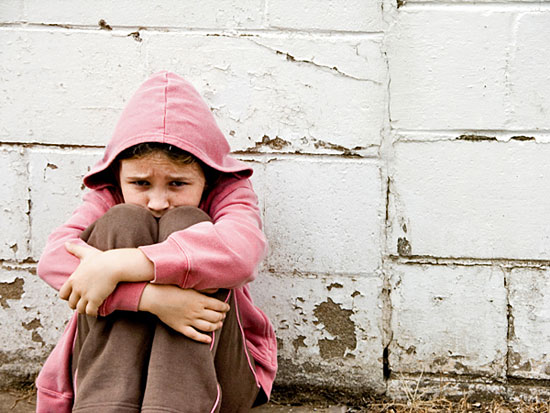
Children, families and veterans are among the more than 50,000 people living on L.A. county's streets.
As Thanksgiving approaches and we gratefully count our blessings, we also reflect on those who are consigned to society’s sidelines, living without roofs over their heads and cut off from the comforts of home and family.
They include, in our county alone, thousands of veterans, thousands of young people and families, thousands with physical disabilities and tens of thousands more who are mentally ill.
Reducing their numbers is our moral obligation, a responsibility we all share. Within Los Angeles County government over the course of the past year, we’ve taken that responsibility to heart and created something unprecedented to set us on the right course.
For the first time, we’ve brought together all the diverse departments with a role to play in preventing and ending homelessness and combined them into a powerful and dynamic force—the Los Angeles County Interdepartmental Council on Homelessness.
On November 15, the council’s initial year of work culminated in our adoption of the county’s first-ever roadmap for addressing homelessness. This roadmap taps into the collective wisdom, expertise, street smarts and tactics of more than a dozen departments and establishes how each will play a role in finding solutions and aiding those who so desperately need it.
It’s intended to cut through bureaucratic obstacles and focus on results, including more permanent supportive housing, better data sharing and teams that will work across departmental lines to provide services and leverage available funding for maximum impact. Proven, money-saving successes like Project 50 can become models for a countywide “housing first” approach.
But a roadmap is just that—a guide to where we’re going. It’s only as good as the drivers behind the wheel, and clearly, there will be many detours, off-ramps and obstacles to navigate before we reach our destination.
In other words, as challenging as it was to create, coming up with the roadmap was easy compared to the daunting journey that lies ahead.
As I’ve said before in this space, and no doubt will again, homelessness remains a great stain on our society. For a country as rich and well-endowed as ours, it is shameful and inexplicable to have so many of our fellow citizens sleeping out on the streets each night, including children, families and veterans who have answered the call of service to our nation.
We owe them better. With more than 50,000 homeless people counted on our streets last year, the need for action and for true, lasting results is immense.
It is our time—and our obligation—to do something big.
We’ve got the map. Where we go from here is up to us.
Posted 11/16/12
Some post-election reflections
November 8, 2012
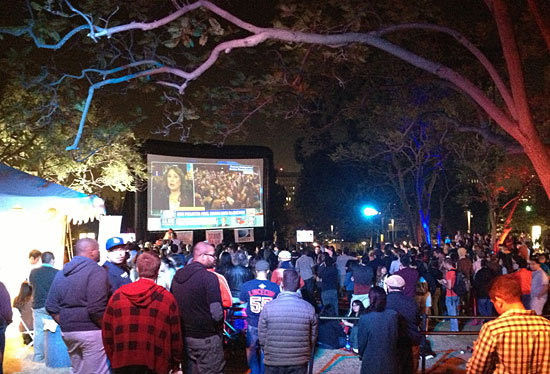
An election night crowd gathers to watch the returns in Grand Park, outside the county of Hall of Administration.
As Churchill once said, “Democracy eventually does the right thing, but only after exhausting all of the alternatives.” The same could be said of California voters, a group that’s a lot smarter than the “political experts” give them credit for.
This year they largely got it right.
Thanks to them, the state of California has taken a step back from the financial precipice. By approving Proposition 30, voters helped California take a giant step toward stabilizing its finances. Failure to do so threatened every service the state provides, starting with education. Now, California and its citizens can catch their collective breath.
Voters’ passage of Proposition 39, meanwhile, plugged a loophole that allowed California companies that do business outside the state to avoid taxes here. Now, those companies will have the privilege of paying taxes like the rest of us. And the funds that will be captured as a result will further help stabilize California’s finances.
And in rejecting Proposition 32, the California electorate saw through the measure and recognized that it is inherently unfair to allow conservative, multiple-million dollar PACs to fund elections while preventing their labor counterparts from leveling the playing field.
We had a disappointment on County Measure J, which would have extended the ½-cent sales tax to allow the MTA to accelerate construction of mass transit and highway projects that were previously approved by county voters. Measure J came within less than two percentage points of the required 2/3 vote, but it didn’t quite make it. It’s a disappointment to me because we had the opportunity to take advantage of record low interest rates and construction costs that would have allowed us to build out our transit infrastructure in 12 years, instead of 30. Now we will remain stuck with a 30-year schedule which will undoubtedly cost billions more as interest rates and construction costs rise over time.
Finally, on a personal note, I will be very sorry to see our San Fernando Valley Congressman Howard Berman leave office at the end of the year. He has been one of the most outstanding members of Congress for the last 30 years. Howard has been one of the most respected Congressional voices on foreign policy, immigration and other important issues facing the nation. He was also a great representative for the Valley and Los Angeles County. He will be sorely missed. However, I have a feeling we haven’t heard the last of him yet.
Overall, voter participation was lower than it was in the last Presidential election of 2008, and that was disappointing. As President Obama said on Tuesday night, there are people all around the globe who risk their lives for the right to vote, but here at home, too many of us take that right for granted. To those of you who did your part, regardless of how you voted on the candidates or the ballot measures, thank you. Our democracy can only work if we all participate. And that participation is not just a quadrennial exercise, but in truth must be a year-round commitment.
Posted 11/8/12
For jobs’ sake, don’t stop Expo
October 23, 2012
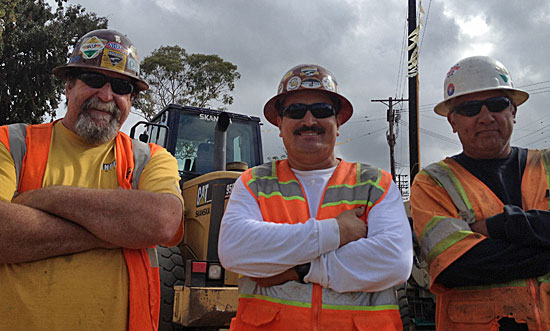
With 400 construction workers already building Expo Phase 2, a court-ordered stay would be devastating.
For more than a year, construction crews have been hard at work on the second leg of the Expo Line, building bridges that will separate trains from surface street traffic and laying the groundwork to extend the popular light rail line all the way to Santa Monica.
Some 400 construction workers are on the job today, along with more than 4,000 others whose work is directly or indirectly tied to the project.
But, with $300 million already spent on this urgently-needed $1.5 billion project, there’s an obstacle that’s suddenly threatening to stop Expo in its tracks.
While this light rail project enjoys widespread public support as an important transit alternative to the severely clogged 10 Freeway that runs alongside it, a small group in the neighborhood has been waging a long-running battle against Expo. Their arguments, challenging the project’s environmental review process, already have been rejected at the state trial and appellate court levels, and now are before the state Supreme Court.
I’m confident that the Expo Authority, which won at both the state trial and appellate court levels, will prevail again before the California Supreme Court. But in the interim, there’s a new and worrisome twist in the case: the challengers are asking the high court to issue a stay that would immediately shut down work on the project until the justices have decided the matter.
This week, I joined with other local officials in calling on the court to please keep the Expo project rolling forward without interruption.
Shutting down work at this juncture would be devastating on so many levels. Our recession-wracked region still has unemployment that’s way too high—and it’s even worse among construction workers.
Just ask Lawrence Douglas, a carpenter apprentice who just started working on Expo a month ago, after 14 months of looking for work. Or Tim White, a crane operator who’s also found work—but wonders whether the job will disappear abruptly in the next few weeks. Or Clementino Perez, a drilling supervisor who knows that each paycheck ripples out well beyond the individual who earns it: “We have a lot of people working over here, and if they shut us down, we’re going to be staying home. That affects the economics for all our families.”
And the impact doesn’t stop there. The county’s taxpayers, who are paying for the project with funds from the voter-approved Measure R, will see the tab go up by at least $90 million if there’s a court-ordered stop in construction. And the project would take at least a year longer to build—which is bad news for the tens of thousands who are looking forward to ditching their cars and riding the train each day. (Already, Expo’s first segment, from downtown Los Angeles to Culver City, is attracting 20,000 riders a day, and growing.)
Attorneys representing the Expo Line recently filed papers with the California Supreme Court strongly opposing the neighborhood group’s motion for a stay. I believe their arguments are extremely persuasive, and that the high court will see the importance of keeping this project moving forward even while the case as a whole is under review.
But I also think that this issue is too important to be left just to the lawyers. Everyone in Los Angeles has a stake in this project.
Let’s keep Expo on track to open all the way to Santa Monica by 2015, and please, let’s keep construction workers out of the unemployment lines and out on the front lines of building a better transit future for all of us.
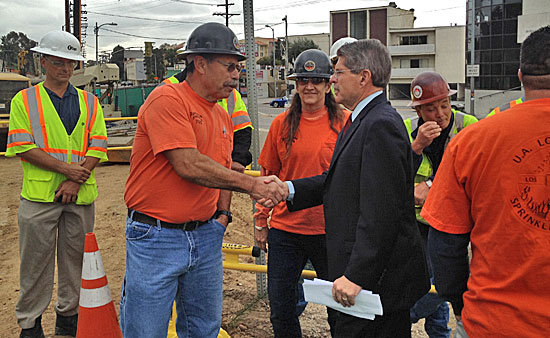
Supervisor Yaroslavsky greets workers this week at the future site of Expo's National/Palms station.
Posted 10/23/12
The $6 billion question
October 10, 2012
On November 6, voters will have some important choices to make—and here in California, the vote on Proposition 30 is as crucial as they come.
The Board of Supervisors voted this week to formally support Prop. 30, a temporary but essential measure that would avert devastating cuts in education by raising personal income taxes for our state’s highest earners—those making more than $250,000 a year—for seven years, while increasing sales taxes by ¼-cent for the next four years. If approved, Prop. 30 would bring in an estimated $6 billion a year, with 89% of that going to K-12 education and 11% to community colleges.
The measure, put forward by Gov. Jerry Brown, also includes something that’s especially important to all of us in Los Angeles County: a local funding guarantee for state-imposed public safety realignment programs. This guarantee means that the state can’t send thousands of prisoners into Los Angeles County without providing us with the funds required to deal with the influx, and all the resulting public safety issues that go along with it.
Clearly, Prop. 30 is not an ideal solution. Raising taxes, even temporarily on those most able to afford the increase, is never fun. But this is a far-from-ideal situation we’re dealing with here.
Sacramento’s fiscal mess has been decades in the making, and deep spending cuts are needed to dig out of the hole. Prop. 30 aims to offer some relief on the revenue front.
This election is so important on so many levels. As you prepare to cast your ballot, I urge you to take the time to learn more about this proposition.
Here is a link to the motion I co-authored with my colleague, Gloria Molina, along with the analysis from the state Legislative Analyst, posted on the Secretary of State’s website for the November election.
And if you haven’t registered to vote, there’s no time like the present. You can even do it online, thanks to a pilot program by our county Registrar-Recorder. Just click here.
Posted 10/10/12
The real work starts now
October 4, 2012
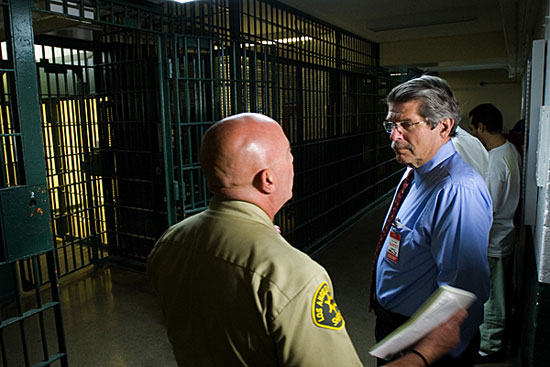
Supervisor Yaroslavsky visits Men's Central Jail shortly after creation of the blue-ribbon commission.
One year ago this month, the controversy over alleged deputy brutality inside the jail was threatening to utterly erode public confidence in the constitutional performance of the Los Angeles County Sheriff’s Department, our region’s largest law enforcement agency.
Not only were inmates accusing deputies of bone-breaking beatings but civilian observers—including a jail chaplain—had provided the American Civil Liberties Union with affidavits saying they’d witnessed fierce and unprovoked attacks. There were also revelations of a federal investigation into the widening allegations.
Under increasing fire, Sheriff Lee Baca publicly said at the time that his command staff had kept him in the dark about the problems but that he was determined to bring order and integrity to the county’s massive jail system—an entirely credible pledge given the sheriff’s longtime advocacy for inmate educational programs. To get to that point, however, would be no easy task.
In the midst of the uproar, I called Sheriff Baca and asked if I could meet with him in his office in Monterey Park. I arrived two hours later with a specific idea to help restore public trust in the department and in the broader leadership of the county, including the Board of Supervisors. One-on-one with the sheriff, I suggested that the board create a no-holds-barred blue-ribbon commission to investigate the origins of the jail problems and recommend reforms for the future. I believed that, with the sheriff on board, he’d be more likely to support the outcome.
He didn’t hesitate for a moment. Let the chips fall where they may, he said. Within days, I introduced a board motion with my colleague Mark Ridley-Thomas to create the Citizens’ Commission on Jail Violence. Its mandate: to excavate and expose the truth.
Last week this distinguished panel of seven commissioners released its final report. And it was, as we requested, unflinching in its assessment of what went wrong and what must be fixed. The bottom line was this: multi-faceted breakdowns in the management of the county’s jails—and deep flaws in the department’s disciplinary system—had created an environment ripe for unchecked brutality by deputies. The commission placed responsibility for these failings squarely on Baca and his second-in-command, Undersheriff Paul Tanaka. “Simply stated,” the panel wrote, “the Sheriff did not pay enough attention to the jails until external events forced him to do so.”
What makes the commission’s conclusions particularly difficult to ignore or dismiss is that they were rendered with unanimity by panelists of varying demographic and political stripes, from federal judges appointed by Republican and Democratic administrations, to the chief of police of Long Beach to a revered pastor in South Los Angeles.
Yesterday, Sheriff Baca summoned the media to Men’s Central Jail to comment publicly for the first time on the report, which not only took him to task but offered more than 60 recommendations for reform, including more rigorous independent oversight. “I couldn’t have written them better myself,” Baca said, reminding reporters that “I wanted this commission as much as the board did.” As he has done repeatedly over the past months, Baca again acknowledged his failings in the matter.
I appreciate and respect the sheriff’s willingness to publicly take responsibility for his department’s shortcomings, an admirable and longstanding characteristic of his management style. But the occasion at hand calls for more than words of contrition or pledges of reform that could fall short of their expressed ideals without sustained, aggressive action on the sheriff’s part.
The jail commission noted that their final report actually is just a starting point, something that all of us with a public responsibility—and a duty to uphold constitutional rights—should keep in mind. I pledge my support to do whatever I can to work with the Sheriff’s Department to bring about the kind of structural and cultural changes the commission has recommended. And above all, we must avoid the outcome the panel fears most: that the report will collect dust on a shelf, like too many reform efforts of the past.
Posted 10/4/12
Let’s make it a non-event
September 27, 2012
When it comes to traffic, nobody is savvier than the L.A. driver.
We check the traffic report before we leave the house, guard favorite surface street alternatives like state secrets, and know that a fender-bender on one side of town can quickly morph into commuting misery many miles away.
In other words, we know that we’re all in this together.
That’s why we were able to prove all the skeptics wrong last year when we sailed through Carmageddon without a SigAlert in sight. People heeded the warnings, stayed well away from the 405 Project construction zone and—strangely enough—ended up making it a weekend that Los Angeles long will remember fondly.
Now we have an opportunity to do it all again. Our destiny is once more in our own hands as Carmageddon II closes down a 10-mile stretch of the nation’s busiest freeway, the 405, for 53 straight hours this weekend to allow for the safe demolition of the Mulholland Bridge as part of an ambitious freeway widening and modernization project.
The first on- and off-ramps will start closing at 7 p.m. on Friday, and by midnight, the entire freeway will be shut down in both directions, all the way from the 10 Freeway to the 101.
Clearly, despite the positive outcome last summer, the potential for major gridlock is still there. You can’t take away a route traveled by a half-million motorists every weekend and expect things to go smoothly—unless we all change our ways for 53 hours.
But Angelenos proved during the first Carmageddon that changing our ways isn’t just about meeting our civic responsibility. It also can be a heck of a lot of fun.
So please, follow the official advice to stay out of the construction area and eat, shop and play locally. It’s a welcome chance to get to know our own neighborhoods better, to patronize a local business that we’ve been meaning to try, or to check out a nearby arts happening.
Or if you prefer to venture out of your neighborhood, leave your car at home and test-drive our constantly improving public transit system. Since the first Carmageddon, Los Angeles has gained more than 12 miles of new mass transit lines: the Expo Line light rail running from downtown L.A. to Culver City, and the Orange Line Extension rapid transit busway from Warner Center to Chatsworth.
This weekend, both lines can serve as portals to the big wide world beyond the Carmageddon II impact zone, especially for residents of the Westside and the San Fernando Valley. Riding the Orange Line Extension to Chatsworth, for instance, makes it possible to connect with Amtrak and ride up the coast for a stress-free, car-free weekend in Santa Barbara. Hopping aboard Expo in Culver City offers an easy way to get to destinations including the county Natural History Museum in Exposition Park or LA Live downtown, where the Herbalife Triathlon Los Angeles finishes around mid-day on Sunday. The possibilities are endless.
However you spend Carmageddon II weekend, have fun, stay out of the car as much as you can and try to see it as a needed respite from our busy, on-the-go lives.
Monday morning will be here before you know it.
For detailed maps of where the construction is happening, and how to avoid it, click here. In addition, Caltrans’ new QuickMap offers up-to-the-minute reports on road conditions. Be sure to click the “slow-fast” icon at the top of the left-hand column for color-coded real-time traffic information.
Posted 9/27/12





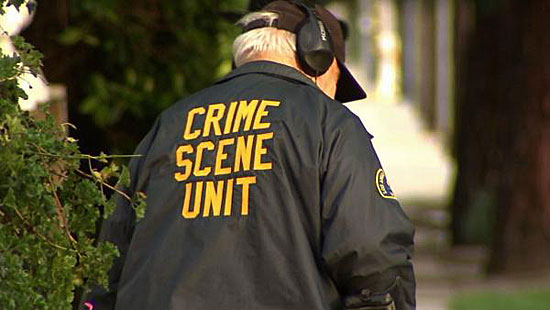


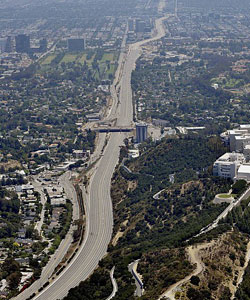





 Check for the latest closure information
Check for the latest closure information








